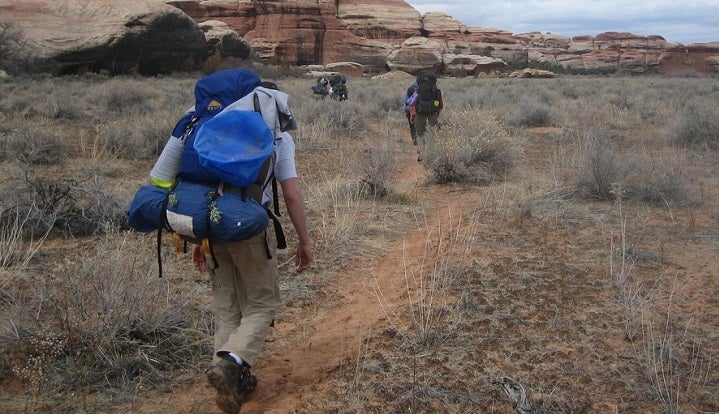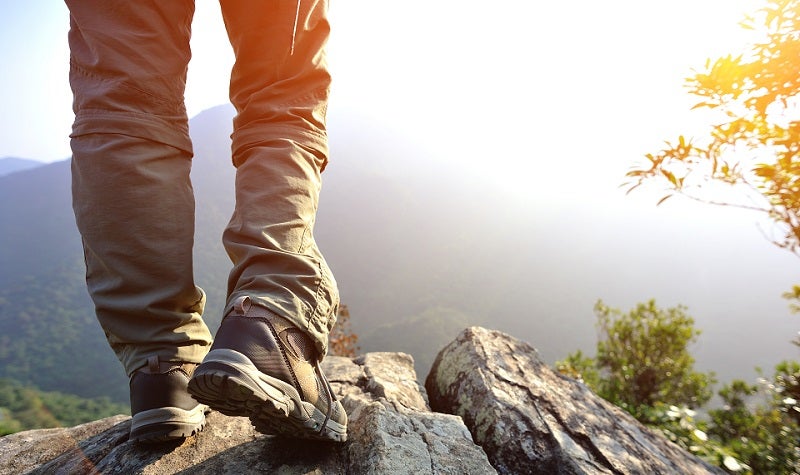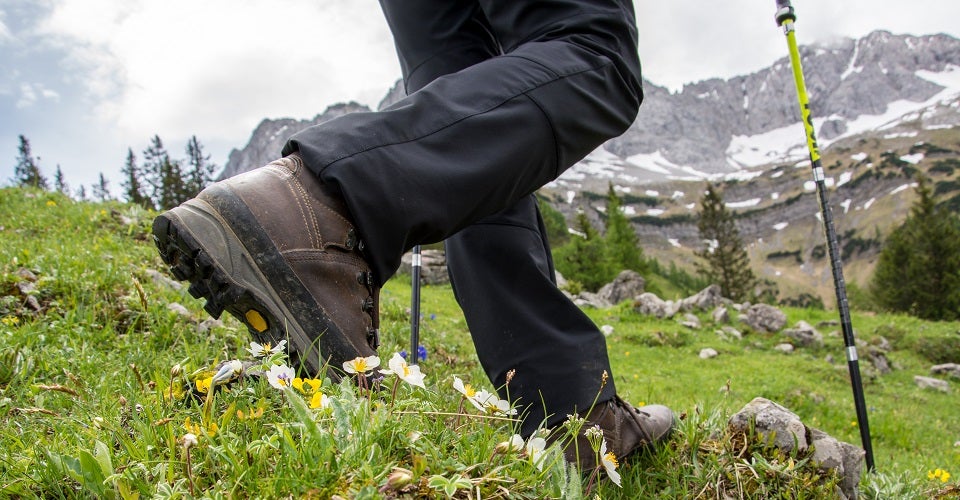
Our Editors independently research, test, and rate what we feel are the best products. We use affiliate links and may receive a small commission on purchases.
There’s a big difference between your dark pair of hipster blue jeans from Abercrombie and the best hiking pants for an overnight trip or a long trek.
Some of the differences might be easily evident such as wearing loose fitting pants for range of movement when hiking. Other differences may be less obvious and a few of them I had to learn the hard way.
When shopping for quality hiking pants its easy to be intimidated by inflated price tags and hyped up claims.
We’re going to take a look at my top hiking pants and why they make such great choices for hikers of any ability level.
Ladies: we created a separate list of hiking pants specifically for women.
Best Hiking Pants
For more of my hiking gear recommendations, have a look through these popular Outside Pursuits guide links: Hiking Shoes, Hiking Boots, Hiking Poles.
Quick Answer: The Best Rated Hiking Pants For 2021
- Outdoor Research Cirque Pant
- prAna Stretch Zion Convertible
- Columbia Royce Peak Pant
- Outdoor Research Voodoo Pant
- Mountain Hardwear AP Pant
- Columbia Silver Ridge Convertible Pants
These are my top rated hiking pants with full reviews, comparison table and our buyers guide on how to choose the right pants below.
Hiking Pants Reviews
#1 Outdoor Research Cirque Pants
- Articulated Knees
- Reinforced Boot Lace Hook
- Gusseted Crotch
- Nylon-reinforced abrasion patches
If you’re looking for a pair of pants that can hack it on a weekend hike or a month-long trek through some seriously rugged terrain these are a solid choice.
The Outdoor Research Cirque pants have thick nylon-reinforced abrasion patches, articulated knees (see what that is below), boot lace hooks, and a gusseted crotch.
Outdoor Research has created a feature rich pair of Men’s hiking pants and I can’t think of anything missing from these pants.
With a flat waistband will remain comfortable under a loaded pack and the adjustable Velcro belt on each side will make sure the pants fit a wide range of sizes.
They are made from a combination of nylon, polyester, and spandex which means these pants are tough, stretchy, and moisture wicking! They come ready to be worn with suspenders thanks to built-in attachment points, too.
Hard to go wrong here and the Outdoor Research Cirque trekking pants are pick for the top hiking pants.
Women’s Model: Outdoor Research Women’s Cirque Pants.
#2 prAna Stretch Zion Pants
- DWR Finish
- Roll-up leg snaps
- Integrated belt
Whether you want a great pair of pants for a month long trek on the Appalachian Trail or just want to be comfortable flying cross country you will be happy with these prAna stretch Zion pants.
They have a inseam gusset that makes them comfortable wearing all day.
They are not water resistant but they do have a DWR water repellent finish that help repel water and even if you do get caught in the rain, they are thin and dry quickly.
These particular backpacking pants are not convertible, meaning they don’t convert to shorts by unzipping and removing the legs. They can be rolled up and secured with a snap button however if you’re still interested in being able to adjust the length.
The fabric resists wrinkling so they are ideal for traveling and they also remarkably abrasion resistant so they can take a beating. The nylon/spandex fabric is breathable and with the spandex have some stretch giving them an extra measure of comfort.
They have 2 pockets for storing your valuables have an adjustable waist so you can get the perfect fit. They also have 2” belt loops if you want the option of wearing a belt.
Having a slightly heavier weight fabric then most other hiking pants, they are ideal for cooler weather but with the convertible option they are well suited for warmer weather as well.
The Zion’s have triple stitching in high stress areas so they are durable and should last you a long time even with the abuse of rock climbing. They are comparable to Arc’teryx pants at a fraction of the price.
Women’s Model: prAna Women’s Regular Inseam Halle Pant
#3 Columbia Sportswear Royce Peak Pants
- Omni-Shade UPF 50 sun protection
- Omni-Shield for water repellentancy
- 96% Nylon / 4% Elastane
- Zip-closed security pocket
While I haven’t worn these pants personally, my hiking buddies own them and having nothing but good things to say about them. These trekking pants come with the reputation of a great outdoor gear manufacturer.
Columbia, as I’ve always said, creates the absolute best gear in the industry for the value – that is to say you’ll pay less for a great piece of gear than with any other maker.
They feature a two-way stretch material that is made from weaving elastane into the nylon.
This maintains the durability and rugged toughness of the nylon while introducing a small amount of stretch and movement into the fabric for hiking and moving over rough or uneven terrain.
Columbia’s Omni-Shield system is even made to shed water and stains from these sweet-looking pants. These are a pair of hiking trousers that can hack a day of trail use or a day in the yard.
Women’s Model: Columbia Sportswear Women’s Saturday Trail Pants
#4 Outdoor Research Voodoo Pants
- Articulated knees
- Gusseted crotch
- Water Resistant and Quick Drying
- Harness compatible waist
The Outdoor Research Voodoo hiking pants are by far the most stretchy hiking pant we’ve reviewed here – these pants are rocking a 12% elastane content for serious movement and stretch.
Thanks to the nylon they’re also windproof and water resistant. Again, these outdoor pants are well-designed with a thin and flat waistband to minimize irritation and chafing while wearing a pack.
While slightly less hardcore than the Cirque pant, these pants feature a handful of helpful pockets. However, I think you’ll find these are the best outdoor pants for hiking and you don’t want to carry items in your pockets.
Store your goodies in your backpack and take advantage of the sleek pants pockets for holding your wallet and phone when you head to the bar after a long day of hiking.
If you want the option of convertible pants, check out the Outdoor Research Ferrosi pants.
Women’s Model: Outdoor Research Women’s Voodoo Pant
#5 Mountain Hardwear AP Pants
- DWR Finish
- UPF 50 sun protection
- 4 pockets and front phone pocket
The Mountain Hardware AP pants are seriously stylish yet no-nonsense for weekend hiking or even longer trips in the right situations.
They are made from a blend of cotton, nylon, elastane and fitting with an athletic aesthetic, they’re just as comfortable for a fancy dinner as they are at the trailhead.
With a flat waistband lined with microfleece and belt loops for any size belt, they can easily be adapted to backcountry of front-country use with ease. While they are not convertible you can roll up the pant legs and secure them with snap closures.
I would definitely pick up a pair of these pants for all-around use because few things are as beautiful as a piece of great gear that can be worn to a nice dinner.
Mountain Hardwear tends to also fit slim and long body builds so be aware of sizing when ordering from Mountain Hardwear.
Women’s Model: Mountain Hardwear Women’s Dynama Pants
#6 Columbia Silver Ridge Convertible Pants
- Zip-off legs
- Omni-Wick advanced evaporation
- Omni-Shade UPF 50 sun protection
- Cargo pants
If you’re a fan of Columbia products like I am and want a pair of convertible hiking pants the Silver Ridge pants are an excellent choice.
Unlike the Columbia Royce pants, these zip off above the knees. Im a huge fan of convertible pants. The flexibility they offer is hard to beat.
Perfect for all day use, cool in the morning? Use them as pants. When it warms up in the afternoon, just unzip them and stay cool. The Silver Ridge pants are made from a thin, comfortable nylon that have excellent wicking abilities.
Keeping you cool and dry in the summer while being surprisingly warm in cold weather. They have 2 side cargo pockets that zip closed to keep your valuables secure and 2 rear pockets that Velcro closed.
They trekking pants feature Columbia’s “Omni-Shade” and “Omni-Wick” which is their fancy terms for they protect you from the sun, no sunscreen needed and they keep you dry by allowing your sweat to evaporate through the pants.
While you probably won’t be wearing these pants to any fancy dinner parties, they are a good looking pair of pants and probably the best lightweight hiking pants for a bargain price.
Women’s Model: Columbia Women’s Aruba Convertible Pant
Hiking Pants Comparison Table
How to Choose Pants for Hiking & Backpacking – Buyers Guide
- Material
- Zip Off and Convertible Options
- Seams and Waistband
- Weight
- Pockets
- Gussets and Articulated Knees
- Belts
- Water Resistance
- Packability
- Best Hiking Pants Brands
- FAQs For Hiking Pants
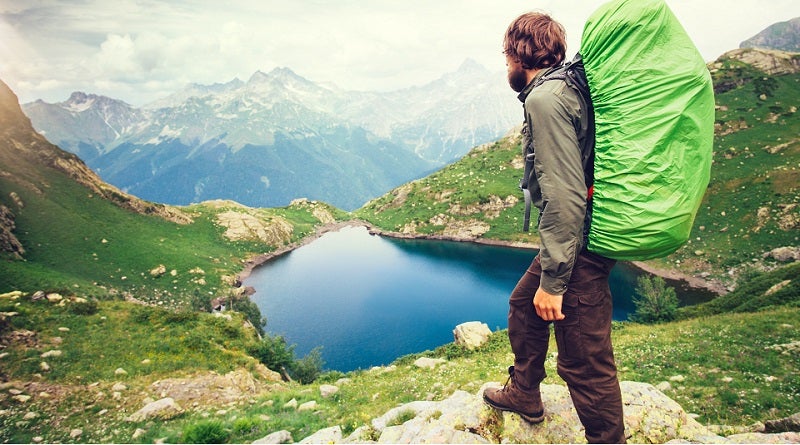
When we pick out a pair of good hiking pants there are several key factors at work and each will matter more to some and less to others. Understanding what materials your pants are made from, why they’re designed certain ways, and what features really matter can help sort out the value from the noise.
Always keep in mind, too, that a good pair of nylon hiking pants can last a dozen years or more of normal use without a problem.
Fabric Materials
For a good pair of hiking pants, we want something durable and functional. Choosing a pair of hiking pants made from the correct material (fabric) is critical and your choices, by and large, are nylon or polyester. We don’t see a cotton blend used often in hiking pants.
Each of these has its own unique pros and cons so let’s examine each:
Nylon
This fabric type is highly waterproof, windproof in most forms, and extremely durable. Nylon fabrics are synthetic, meaning man-made, and can last an extremely long time in the right applications.
Nylon does a poor job of wicking moisture but that’s not necessarily the job of hiking pants anyways, so it’s no big deal in this case. If your looking for a pair of waterproof hiking pants, nylon is the way to go.
Nylon is used in many outdoor applications such as tents, backpacks, and dry sacks to name only a few. Thick nylon such as 600 denier is often used for its notoriously good abrasion resistance and durability in places like the bottom of backpacks.
Pros:
- Windproof
- Water Resistant
- Durable
Cons:
- Does not wick moisture well
Polyester
This fabric is also synthetic but shares few of the same properties of nylon. Polyester is often used as “base layer” fabric due to its inherent ability to “wick” moisture away from the surface of the skin and are ideal in hot weather.
Polyester is the main fabric in most UnderArmour garments and other tight fitting performance layers.
Unfortunately, polyester is not nearly as durable or abrasion resistant as nylon despite the fact that it performs better as a wicking fabric.
Often polyester will be woven with nylon or a durable water resistance coating in a garment to help blend the relative strengths of each fabric to create a final product that is both strong, durable, and wicking.
Zip Off and Convertible Options
Convertible pants are where the lower legs and be removed by unzipping them. Many backpackers and hikers prefer zip off or roll up pants because they offer a two-in-one solution to the needs of differing weather conditions and are ideal in hot weather.
There was a time when zip off pants were a novelty item but these days in the hiking world, zip off pants have come to be a genuinely useful tool.
When choosing zip off pants it may be pertinent to choose a well-crafted pair of pants from a reputable hiking gear manufacturer.
Why?
Because many cheap zip off pants from the local Walmart have weak zippers or poorly constructed seams and won’t last very long at all. Make the investment in a good pair of zip off hiking pants.
An alternative, however, might be to wear a pair of running shorts for hiking in warm weather and carry a pair of lightweight roll up nylon pants for in camp or when resting if the idea of zip off pants is not particularly appealing.
Seams and Waistband
Probably the single most overlooked factor which sets great hiking pants apart from the crowd is the waistband.
If you’ve not spent much time carrying a backpack, then it may not occur to you that the hip belt of a heavy backpack rests directly over the waistband of most pants.
Wearing a belt or using pants with particularly thick waistbands can cause lots of discomfort, pain, and even raw skin or blisters.
Great backpacking pants will have a soft lined waistband such as micro fleece along with a nearly flat waistband construction to improve comfort under the hip belt of a backpack. Trust me, it’s well worth the investment.
Flat sewn seams are also a feature of well-made hiking pants. These seams are sewn down flat against the garment so that they don’t chafe or rub against the skin in critical points.
Most hiking pants will feature this seam construction but double check for it before purchasing.
Weight
While not a big concern for most hikers since they are usually wearing the same pair of pants and wash them when needed.
However, over the course of a days or a week you will start to notice a difference if you have a heavier pair of pants on, especially if you are carrying an extra pair in your backpack.
If this is your plan, then the OR Voodoo pants are an excellent option, if you plan on wearing the same pair for your entire trip, consider the OR Cirque pants. These are an extremely tough and durable pair of hiking pants.
Pockets
They may seem like an afterthought but the type and quantity of pockets can be an important factor. Personally, I don’t like loading down my pockets with gear or other items. I like to use the pockets in the straps of my hiking backpack.
However for things you will be accessing often like a GPS or some snacks having some secure, zippered pockets can be a nice feature. The OR Cirque pants and Arc’teryx Ramparts are an excellent choice in this regard. There is a pocket for most anything you carry to put in them!
Gussets & Articulated Knees: What are they?
Articulated Knees
On better hiking pants you will hear the term “articulated knee” and wonder that the heck that means.
Simply put, it means the cut of the knee is at an angle so they are not straight. You’re probably wondering why that matters but I can assure you it matters a lot!
With the knee “pre-bent” they are significantly more comfortable to knee down with and when hiking for long periods of time they don’t rub or chafe as much. If you can get a pair with an articulated knee, do so, you will thank me.
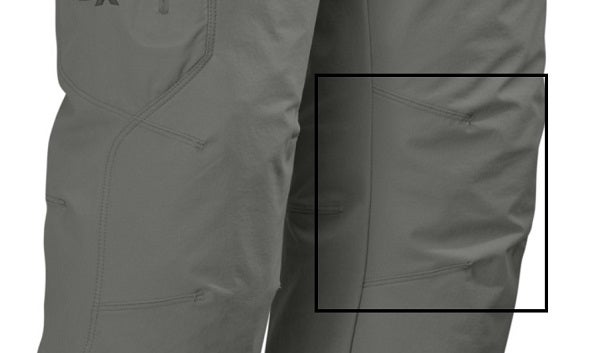
Gussets
Hiking pants with a gusset is usually diamond shaped patch of fabric that is seen in the inner thigh of the pants. Similar in function to articulated knees, they improve the comfort of the pants by giving them an increased range of motion.
This is especially important over long hikes. You will only find this feature in higher end pants like the prAna Zion, OR Cirque or Fjallraven pants because of the extra stitching involved in creating the gusset.
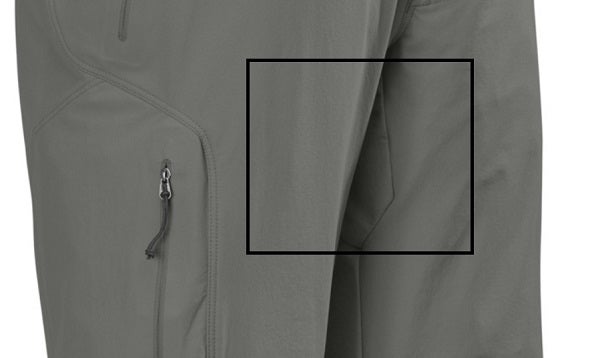
While over shorter hikes neither of these features is critical, but for anything over a day hike, getting a pair of hiking pants with articulated knees and a gusseted crotch is well worth it!
Belts
Having a properly fitting pair of pants can be difficult. This is where an integrated belt can come in handy. Having the belt built into the pants means better integration and a lower profile. The prAna Zion’s are a good example of a pair of pants with an integrated belt.
The better design is one where it doesn’t wrap completely around the pants and cannot be removed. This way it won’t get lost or in the way.
The Columbia Silver Ridge is an example of a pair of pants with a belt that wraps all the way around and can get in the way with a backpack.
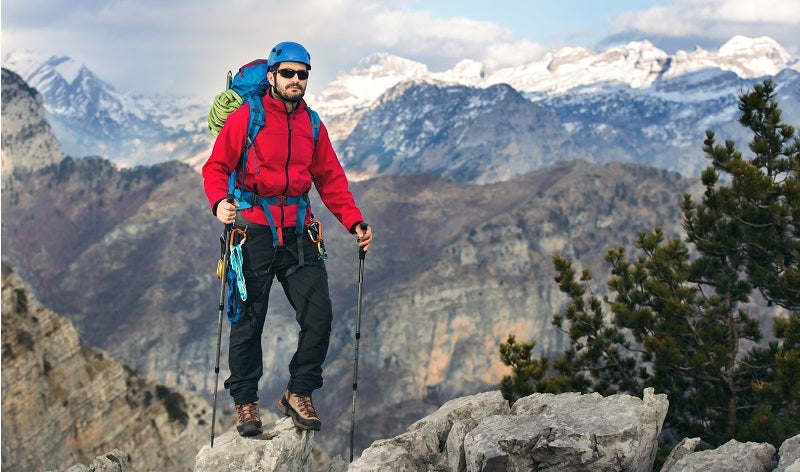
Water Resistance
Lastly let’s talk about water resistance.
Unless we are talking about rain pants, hiking pants are not going to be truly waterproof. But unless your hiking in a major rain shower, a water-resistant pair of hiking pants should be enough.
If you want truly water resistant hiking pants, see my recommendations for rain pants here.
Truly water proof pants would not be very comfortable over any longer term hike because they just don’t breath well and you would quickly overheat wearing them.
Being water resistant with a durable water resistance (DWR) coating like the prAna Zion or the Patagonia Quandary pants have is usually sufficient for everything but a hard rainstorm.
The DWR coating will repel most of the water and if they do soak through, they will dry pretty quickly as well.
Packability
Bulk and weight are both enemies of the backpacker. So, it follows that good hiking pants should be both lightweight and easily packable, right?
Unless you’re specifically looking for thick pants that have extra warmth, I’d recommend minimizing bulk. Unfortunately, there are very few ways to do this other than trial and error.
One way you can gauge bulk is just by comparing weights. If you find two similar zip off nylon pants and one is 3-4 ounces heavier, you can be all but guaranteed that it will also be bulkier.
At the same time, though, manufacturers use different fabric thicknesses, weaves, zippers, seams, etc. All of this means that two hiking pants with similar specs can be substantially different when it comes to packability.
I recommend the tried and true fold+roll method. Fold the pants in half and then roll them up into a bundle as tight as possible. To keep them in their reduced size state, use a rubber band or just pack them tightly with other pants.
Hiking Pants vs Shorts: Which is Better?
Choosing between hiking shorts and hiking pants when heading out on the trail will mostly come down to the weather you expect. If you are going out in the early spring or late fall, pants are the obvious choice. During the warm summer months you will need to make a more difficult decision.
Lets consider some advantages and disadvantages:
Hiking Pants
Will give you protection from the sun, thorns and sticks. Not only that they are almost a requirement for high altitude climbing and technical hikes. Pants can also help keep rocks, mud and rain from getting into your shoes or boots.
Pants will also offer some protection against mosquitoes and ticks. If you are hiking in tick territory, you may want to wear pants regardless. No one wants Lyme disease or one of the other numerous tick borne diseases!
The downside of course with hiking pants is they will be much hotter when the temperature turns hot plus they can also chafe if they are stiffer nylon pants.
Hiking Shorts
The obvious advantage of shorts is comfort during the hot summer months. They will allow you to stay much cooler plus they don’t chafe your legs and just overall more comfortable.
The one compromise is wearing convertible pants and we covered that style of pants above the zip off and convertible section.
Best Brands of Hiking Pants
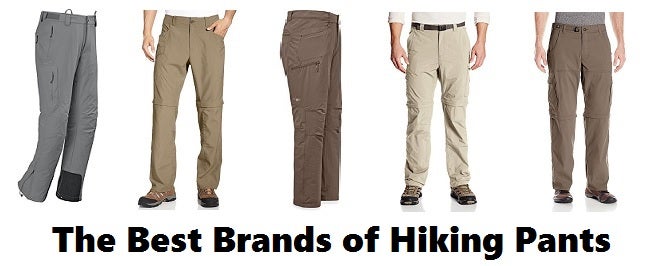 After being a backpacking guide for quite a few years and wearing many different brands of hiking pants I can say these are the best brands:
After being a backpacking guide for quite a few years and wearing many different brands of hiking pants I can say these are the best brands:
Columbia – One of the best value proposition brands on the market, available at Amazon or REI.
Outdoor Research – Since 1981 they have been making quality outdoor gear.
Mountain Hardwear – Got their start making climbing equipment, expanded into hiking pants and jackets.
prAna – Originally made only Yoga clothing, now they made a fine line of hiking pants and jackets. Available at Amazon or REI.
FAQs About Hiking Pants
Q: Do I need convertible hiking pants?
A: Well it depends on the temperature and how much room you have. If you will be hiking mainly during warm weather, I would advise convertible hiking pants. The ability to turn them into shorts is a nice feature. It also saves you needing to pack a separate pair of shorts.
Q: Should I get a pair of pants with an attached belt?
A: I like the hiking pants that have a “half belt” like the prAna Zion pants or the Fjallraven. These pants have a adjustable waistband that does not stretch around and so it doesn’t rub against a backpack. If you are able to get pants that fit great then the belt is an unnecessary addition.
Q: Are hiking pants with an elastic waistband a good idea?
A: Have a bit of “give” or stretch is a good idea. Having some flex makes the pants more comfortable especially if your weight is not constant.
Q: Do I need waterproof hiking pants?
A: In general I would say no. If you will be hiking in the rain, a pair of rain pants would be a better option. Having your primary pair of hiking pants waterproof means they will not be as breathable and will be warmer than a non waterproof pair of hiking pants.
Q: What is the best fabric for hiking pants?
A: There are three main types of fabric that commonly get used in hiking pants. Each type has its own pros and cons and they type of fabric you choose should be based on what you’re trying to do.
Nylon is durable and abrasion resistant. This man made fabric can be nearly waterproof on its own and is highly wind resistant. In some forms it’s totally windproof by itself.
Polyester is a little less durable than nylon. However, it is better overall at wicking sweat and feels a little less like a plastic fabric compared to nylon. Depending on the weave used, poly can be quite wind and water resistant or not at all.
Lycra or Spandex is a fabric material that’s often added into nylon and poly. It gives the finished fabric a lot more flex and stretch which is nice for kneeling, sitting, and moving.
For off trail hiking nylon is great because it resists abrasion from boulders, thorns, and brush. Polyester is great for high-output activities like hiking quickly, running, etc.
Q: Would you advise someone to use zip-offs?
A: Back in the 90’s zip off pants were the thing to do just for fashion. Today, zip off pants pretty much only show up in hiking applications.
Honestly I use them all the time, though not for backpacking very often. I bought them for backpacking but ended up mostly just hiking in running shorts, or running shorts with leggings underneath.
However, there’s really nothing wrong with using zip offs for backpackers and they’re ideal if you’re hiking during seasons when weather is changing quickly. If it’s cold in the morning and blistering hot during midday then consider some zip-offs!
You need to make sure these zip off pants have boot zippers down near the cuffs. Unless you want to take your shoes or boots off every time you need to change zippers, the boot zippers are a must have.
Q: Are built-in belts a bad thing for hiking pants?
A: I don’t think so, personally. In fact, I like built in webbing belts.
The real issue with belts when it comes to hiking and backpacking is bulk. When you put a backpack over the top of your belt, the hip pads can dig in and cause chaffing on belts that are bulky like lage leather belts.
Webbing belts are great because they’re nylon which doesn’t soak up much water when wet and they can be made very slim and flat so they don’t rub when you put a heavy pack strap over the top of them.
When you look for hiking pants that have built in belts, make sure they meet these guidelines or the pants will be all but useless.
Q: Do you recommend cargo pockets for hiking pants?
A: Answer: bad.
Other answer: not so bad.
I think they’re terrible for hiking because any gear you put into hiking cargo pockets tend to flop and bang around against your leg as you hike. Every step you take makes that junk in your pockets rub and flop against your leg which will quickly become annoying at best, painful at worst.
Hiking around with anything in a front pocket is much more uncomfortable than in a pocket on the side of the pants. Generally I like to store snacks or other items in a hip pocket of my backpack.
However, for a short hike or those who want to carry tons of gear on their person, cargo pockets aren’t so bad. They’re a good spot to temporarily stash a map or compass and keeping gear on your person instead of in your pack is great in the case that your pack accidentally gets lost…
Q: The mosquitoes are awful around me, what pants will keep them off?
A: Recently, seemingly in a push for more things to advertise, some manufacturers have been making “bug repellent” and “SPF” clothing. Of course, anything over your skin will help repel more bugs than not having clothes on, and the same is true of preventing sunburn, so…
I wonder a little at modern bug repellent clothing and what technology, chemicals, or really tangible bug repelling solutions they really offer, frankly.
That said, if you ignore these advertisements and just think about it logically, nylon makes the most sense.
Flat rolled nylon, or nylon fibers that have been slightly flattened by heat after being woven, are almost entirely waterproof, windproof, and bugproof.
If you can manage to find enough information from the manufacturer about the exact construction process of the fabric used, look for this type of nylon fabric to repel as many bug as possible!
Final Thoughts
As a hiker, it’s important that you understand the different types of materials your pants might be made of.
Among many options the choice for a convertible pant may be one of the more important decisions in the utility value of your new pair of pants.
Without a doubt, however, it’s critical to focus on how the pants will feel when worn with a backpack hip belt fully loaded.
Avoid any pants that are too restrictive or bulky around the waistband. Good hiking pants are durable, adaptable, and will last through years of heavy use.
I have been using convertible hiking pants for years and, while I don’t usually take them backpacking, they often find a place in my daily use. For many hikers, these pants are the perfect combination of utility, durability, and aesthetic.
How We Researched
To come up with the top hiking boots we researched a variety of sources for reviews such as REI, Bass Pro Shops, Cabelas and Backcountry along with our own personal experience.
We also consulted online magazines for product research and reviews to get as much unbiased information as we could. To help weed out fake reviews we used Fakespot.com to make sure we only looked at genuine reviews.
With so much quality gear available, we had to narrow it down based on what we felt were the best options for the price. The author, Casey Fiedler has been leading backpacking trips for over a decade in his native state of Michigan.
To help narrow down the selection he used his personal experience along with recommendations from fellow guides and outfitters.
After extensive research, we came up with our list to help you choose the right one for you.
Sources

